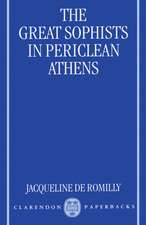The Insula of the Menander at Pompeii: Volume 1: The Structures: Insula of the Menander at Pompeii
Autor Roger Ling Contribuţii de Paul Arthur, Georgia Clarke, Estelle Lazer, Lesley A. Ling, Peter Rush, Andrew Watersen Limba Engleză Hardback – 14 mai 1997
Preț: 1734.23 lei
Preț vechi: 2634.62 lei
-34% Nou
Puncte Express: 2601
Preț estimativ în valută:
331.85€ • 347.35$ • 276.20£
331.85€ • 347.35$ • 276.20£
Carte tipărită la comandă
Livrare economică 19-25 martie
Preluare comenzi: 021 569.72.76
Specificații
ISBN-13: 9780198134091
ISBN-10: 0198134096
Pagini: 412
Ilustrații: numerous halftones and line figures
Dimensiuni: 228 x 286 x 31 mm
Greutate: 1.11 kg
Editura: OUP OXFORD
Colecția OUP Oxford
Seria Insula of the Menander at Pompeii
Locul publicării:Oxford, United Kingdom
ISBN-10: 0198134096
Pagini: 412
Ilustrații: numerous halftones and line figures
Dimensiuni: 228 x 286 x 31 mm
Greutate: 1.11 kg
Editura: OUP OXFORD
Colecția OUP Oxford
Seria Insula of the Menander at Pompeii
Locul publicării:Oxford, United Kingdom
Recenzii
This book is the beginning of a magnificent publishing project. Without levels of protection and restriction so far unimagined at Pompeii, future scholars may come to value it even more than should we.
The book is clearly laid out, with a plan and structure that are easy to follow ... L. has given us a vivid picture of the gook, the bad, and the ugly sides of life within a Pompeian insula, and of the 'inequalities of wealth and power in Pompeian society' ... This is a major contribution to Pompeian studies, and the succeeding volumes can only be eagerly awaited.
Ling's account of the changes to the House of the Menander over time demonstrates how careful observation can provide a detailed history of a building.
The book is clearly laid out, with a plan and structure that are easy to follow ... L. has given us a vivid picture of the gook, the bad, and the ugly sides of life within a Pompeian insula, and of the 'inequalities of wealth and power in Pompeian society' ... This is a major contribution to Pompeian studies, and the succeeding volumes can only be eagerly awaited.
Ling's account of the changes to the House of the Menander over time demonstrates how careful observation can provide a detailed history of a building.




















